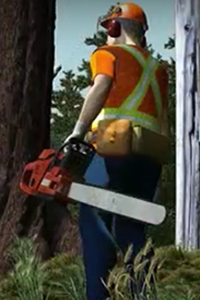Faller dies when struck by large slab of dangerous tree
Date of incident: May 2009
Notice of incident number: 2009158930099
Employers: Lemare Lake Logging Ltd., International Forest Products Ltd.
Incident summary
A faller was trying to overcome a falling difficulty by himself. He made cuts and placed wedges in three green trees so that he could use two of them to push over the third. The third tree was limb-tied with a nearby dead dangerous tree. (A dangerous tree -- as defined by the provincial Occupational Health and Safety Regulation -- poses a hazard to a worker for any one of several circumstances or conditions, including physical damage.) The trees began to fall in succession. As the third tree fell, its branches caused a large slab to break off the nearby dangerous tree. The slab struck the faller, causing fatal injuries.
Cause
- Faller struck by slab of wood that broke off dead cedar: The faller was trying to fall three live trees near a large, dead cedar. A long slab broke off the large cedar when the live trees were felled.
- Falling live trees that were limb-tied with a dead cedar: The three live trees and the large dead cedar were close together and limb-tied. As the third live tree fell, its branches caused a large slab to break off the stem of the large cedar.
- Qualified help not used: A faller must seek qualified assistance if one of two limb-tied trees to be felled is a dangerous tree. The faller who was fatally injured had planned the falling of the trees with a high level of skill. However, he did not seek qualified assistance in strict accordance with the BC Faller Training Standard. It is likely that he didn't ask for help because, under the circumstances, it was difficult to do so.
- Alternative falling methods for dangerous trees not adequately incorporated as a workplace practice: Documents provided by the prime contractor and the licensee mention blasting, as an alternative to falling, for removing dangerous trees, but there were no specific procedures for doing this and no readily available blaster.
- Planning did not effectively manage the foreseeable hazard of dead trees: There was no specific workplace plan to deal with large dead cedar trees. The hazards presented to fallers by such trees are well known, and manual falling is the least desirable way of dealing with them. Despite this, the responsibility for formulating a plan to address these hazards often remained entirely with the fallers. There was little flexibility that allowed fallers to leave trees standing.
- Senior supervision did not provide adequate resources: The site supervisor could not manage by himself all the many activities associated with running a camp and falling operations. As a result, the site supervisor did not often go to the cutblock where the incident occurred, and there was no designated bullbucker at the cutblock. There was no consistent supervisory presence in the cutblock to offer help and oversee daily practices.
Link:
Hazard alert

